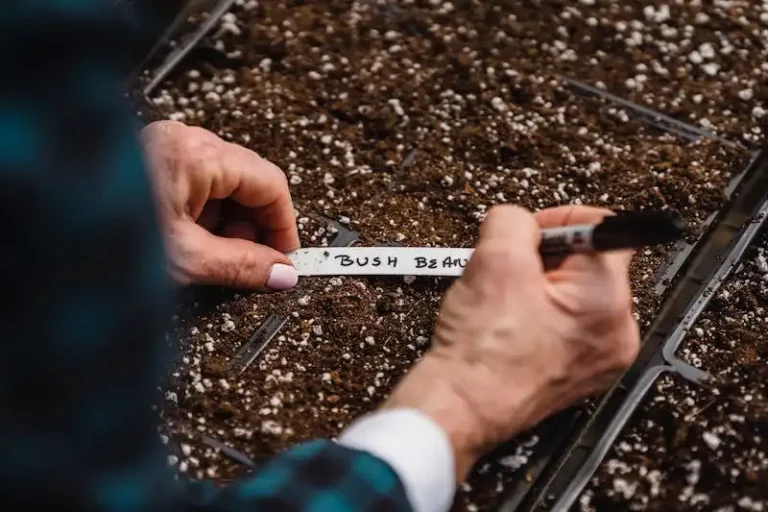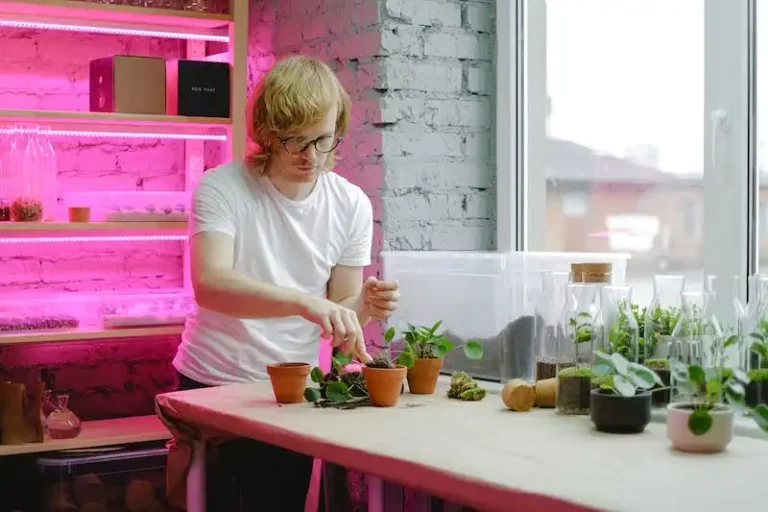Repotting anthuriums is an important part of their care to ensure their future growth and flowering. These tropical plants require special attention and care to thrive in your home. If you are new to growing anthuriums, it is crucial to know the right medium, fertilizer, and watering requirements for these beautiful plants.
Anthuriums are often compared to orchids due to their beautiful and exotic flowers. These plants can grow up to 2 feet tall and prefer warm temperatures with high humidity. They require well-draining soil mixtures and regular watering to prevent wilting. When repotting, it is important to use a lightweight and well-draining potting mix to create the ideal growing medium for your anthurium plants.
To repot your anthurium, start by thoroughly watering it to ensure the soil is moist. Gently remove the plant from its current pot, taking care not to damage the rootball. Fill your new pot with a mixture of peat and well-draining soil, creating an ideal environment for your anthurium plant.
If you’re looking for a cheap and easy-to-find potting mix, consider using a Hawaiian mix. You can find this mix online or at local plant stores. This mix usually contains special ingredients like volcanic ash and orchid bark that help with drainage and create an ideal environment for anthuriums to grow.
After repotting, give your anthurium plant some time to adjust to its new environment. Check for signs of wilting or lack of growth, as these may indicate that the plant needs more water, fertilizer, or higher humidity. Anthuriums are fairly tolerant plants and can adapt to different environments, but they still require regular care to thrive.
In conclusion, repotting anthuriums is an important step in their care to ensure their future growth and flowering. Understanding the required soil, temperature, humidity, and drainage for these tropical plants is crucial to their well-being. By following the simple steps outlined in this article, you can give your anthuriums the care they need to thrive and add beauty to your home.
ANTHURIUM Soil Mix – Houseplant Growing Medium – 3 LB 2 Gallon
The ANTHURIUM Soil Mix is a special blend specifically formulated for the needs of anthurium plants. It provides the ideal growing medium for these tropical houseplants, ensuring healthy growth and vibrant flowers.
Anthuriums are popular houseplants that require specific care to thrive. They are native to the humid forests of Hawaii, where they grow in the wild. To recreate their natural habitat, you need to use a soil mix that mimics the conditions of their native environment.
The ANTHURIUM Soil Mix is a combination of high-quality ingredients, including peat moss or coconut coir, to provide the ideal pH level and moisture retention for the plants. This helps create the perfect balance of moisture and oxygen in the soil, allowing for healthy root development and preventing overwatering.
Anthuriums are tropical plants that thrive in warm temperatures and high humidity. The ANTHURIUM Soil Mix is designed to provide the necessary nutrients and moisture for their growth. It also helps prevent the soil from becoming compacted, allowing the roots to breathe and preventing root rot.
When repotting anthuriums, it is important to use a well-draining soil mix that allows excess water to escape. The ANTHURIUM Soil Mix has a light texture that provides excellent drainage, ensuring that the roots do not become waterlogged and promoting healthy growth.
The ANTHURIUM Soil Mix is also suitable for other tropical houseplants, such as dragon trees or orchids, that require similar growing conditions. It is a versatile and convenient option for any houseplant enthusiast.
This 3 lb bag of ANTHURIUM Soil Mix is enough to fill approximately two 1-gallon planters, giving you plenty of soil for repotting or starting new plants.
Overall, the ANTHURIUM Soil Mix is the best potting mix for anthuriums and other tropical plants. It provides the ideal growing medium to support their growth and flowering, ensuring that they thrive in your home.
Anthurium Plant Care: Learn About Repotting Anthuriums
If you’re a friend of the Anthurium plant, you may have recently come to the end of a high-growth phase and are now considering repotting your Anthuriums. Repotting is an important part of Anthurium plant care, as it allows the plant to continue thriving in a larger container and fresh soil mix. In this article, you will learn tips and guidelines about how to repot your Anthuriums and what type of medium to use.
Before you start repotting, make sure you have the necessary materials. You will need a larger container with proper drainage holes, a mix of cactus and orchid soils, and optionally, some peat moss for further moisture retention. You can find commercially available soil mixes online or at your local garden center. Mixing cactus and orchid soils creates an ideal draining and growing medium for Anthurium plants.
When repotting, carefully remove the Anthurium from its current container. Take care not to damage the roots or the rootball. If the roots are tightly wound, you can lightly loosen them to encourage new growth. Check for any signs of wilting or root rot and trim them if necessary.
Next, prepare the new container by adding a layer of soil mix at the bottom. Gently place the Anthurium into the new container and fill the remaining space with the soil mix. Press the soil lightly around the plant to secure it in place. Make sure not to bury the plant too deep, as this can hinder its growth and flowering.
After repotting, water the Anthurium thoroughly, ensuring that the water drains out of the container. Anthuriums require a high humidity level, so misting the leaves with water regularly can be beneficial. Additionally, you can use a humidifier or place a tray of water near the plant to increase the overall humidity in the area.
For further care, provide your Anthurium with bright indirect light. Avoid placing it in direct sunlight, as this can scorch the leaves. Maintain a temperature around 70-90°F (21-32°C) during the day and slightly cooler at night. Feed your Anthurium with a balanced liquid fertilizer every two weeks to promote healthy growth and flowering.
In conclusion, repotting Anthuriums is an essential part of their care routine. By using the right potting mix and providing optimal conditions, you can ensure that your Anthurium plants continue to thrive and beautify your space. For further information about Anthurium plant care, consult gardening catalogs, online articles, or seek advice from experienced growers. Your Anthurium plant will thank you for the care and attention it receives!
Best time for Repotting Anthurium Plants
Repotting anthurium plants is an important part of their care routine. Knowing the best time to repot can help ensure the health and growth of your anthuriums.
Generally, the best time for repotting anthurium plants is during the warmer months, specifically in spring and summer. This is when the plants are actively growing, and they can recover more quickly from the stress of repotting.
Before repotting, it’s important to prepare the new container and potting mix. Anthuriums prefer well-draining soil, so it’s best to use a mix that contains ingredients like perlite or orchid bark to create a light and airy medium. Some garden centers sell special anthurium mixes, but a mix of regular potting soil and perlite in a 2:1 ratio can work just as well.
When repotting anthurium plants, it’s crucial to be gentle with their rootball. Carefully remove the plant from its current container, and lightly shake off any excess soil. Inspect the roots for any signs of disease or rot, and prune away any affected areas.
Place the anthurium into the new container, making sure it’s at the same depth as before. Fill in the gaps with the new potting mix, being careful not to pack it down too firmly. Once the plant is repotted, water it thoroughly to settle the soil and eliminate any air pockets.
After repotting, it’s important to give your anthurium plants plenty of light, but be cautious of direct sunlight, as it can scorch their leaves. Place them in a location with bright, indirect light. Additionally, avoid overwatering the newly repotted plants as this can create soggy conditions that may lead to root rot.
By following these simple repotting guidelines, you can help ensure the continued health and growth of your anthurium plants. Thanks for reading!
How to Repot Anthuriums
Repotting anthuriums is an important part of their care and maintenance. It is necessary to repot your anthurium plant when the roots outgrow the current pot or when the potting medium is no longer providing the necessary nutrients and drainage. Repotting allows the plant to continue growing and ensures its future health.
Here are the steps you need to follow to repot your anthurium:
- Choose the right time to repot. The ideal time for repotting anthuriums is in the spring or early summer when the plant is in its active growing phase.
- Prepare the new pot. Select a pot that is slightly larger than the current pot but not too big. Anthuriums prefer tight root systems, so a pot that is just one size up is usually the best choice.
- Remove the anthurium from its current pot. Gently loosen the rootball by tapping the sides of the pot or squeezing the sides. Carefully lift the plant out of the pot, supporting the base of the plant with your hand.
- Thoroughly water the plant. Before repotting, water the anthurium plant to help ease it out of the pot, and also to prevent dehydration during the repotting process.
- Inspect the roots. Check the roots for any signs of damage or disease. Trim away any dead or rotten roots with clean pruning shears.
- Prepare the new potting mix. Anthuriums prefer a well-draining potting mix. You can create your own mix by combining equal parts of peat moss, orchid mix, and perlite. Or you can use a pre-made potting mix specially formulated for tropical plants.
- Place the anthurium in the new pot. Position the plant in the center of the pot and fill in the gaps with the new potting mix. Gently press the mix around the roots to secure the plant in place.
- Water the plant. Give the newly repotted anthurium a thorough watering to settle the soil and hydrate the plant. Water until the excess water drains out of the bottom of the pot.
- Find the right location. Place the repotted anthurium in a location that receives bright, indirect light. Anthuriums thrive in temperatures above 60°F (15.5°C) and with high humidity, which makes them perfect for growing indoors in many areas.
- Take care of the plant. After repotting, continue to provide the anthurium with the care it needs. This includes regular watering, providing a humid environment, and fertilizing according to the plant’s needs.
Repotting anthuriums may seem like a complex task, but with some basic knowledge and the right materials, you can successfully repot your anthurium plants. By following these simple steps, you’ll ensure the health and future growth of your anthuriums. Happy repotting!
Thanks for reading! For more articles on anthurium care and other plant varieties, be sure to check out our catalog.

